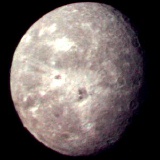 Oberon. |
|
| OBERON - MOON OF URANUS | |
| Oberon is the husband of Titania and King of the Fairies in Shakespeare's play "A Midsummer Night's Dream". It was discovered in 1787 by the British astronomer Sir William Herschel who found Uranus in 1781. Voyager 2 arrived at Uranus in 1986. The images it obtained of Oberon's surface have a resolution of just 20 kilometres and cover only 50% of the planet. Our knowledge of Oberon's surface is very incomplete. | |
| Orbit | |
| Oberon is the outermost of Uranus' large moons, orbiting at a distance of 583,420 kilometres. The inclination of Oberon's orbit to the plane of Uranus' equator is only 0.1o, and with an eccentricity of only 0.008 this orbit is nearly a perfect circle. Oberon completes one orbit of Uranus in 13.463 days, travelling in a retrograde direction opposite to the direction of Uranus' rotation. Oberon's rotation is synchronised to its orbital period, and therefore an Oberon day is the same length as an Oberon year. | |
 The orbits of Uranus' larger moons. |
|
| Physical properties | |
| With a diameter of 1520 kilometres across, Oberon is the second largest Uranian moon, and is about 44% of the size of our own Moon. Oberon has a density of 1630 kg m-3, and a mass of 3.5 x 1021kg. | |
 Comparison between Oberon and our Moon. |
|
| Interior | |
| Oberon is similar in size to Titania but bears a closer resemblance to Umbriel, even though it is much larger. Oberon's density suggests that Oberon probably contains a large amount of water ice. There is possibly also a small amount of frozen methane. | |
| Oberon's surface is heavily cratered. Retaining so many craters, Oberon appears to be virtually unmodified since its formation. Though it probably has a layered interior, Oberon appears to have cooled quickly, as there is little evidence of internal processes at work. | |
| Atmosphere | |
| No atmosphere has been detected. | |
| Magnetic field | |
| No magnetic field has been detected. | |
| Surface | |
| The surface of Oberon is moderately dark, with an albedo of 0.24. It is very likely contaminated with rock dust. An alternative explanation for the darkness of the surface has been proposed - it may be caused by photochemical reactions which convert methane into dark organic compounds. | |
| Oberon has craters ranging widely in size, distribution, and complexity. The size distribution conforms to that expected of an old population and is similar to Umbriel and our own Moon's heavily cratered highlands. | |
 Voyager 2 view of Oberon's cratered surface, from 663,000 kilometres. |
|
| Most of Oberon's craters are between 20 kilometres and 100 kilometres in diameter. The largest craters have fairly level and smooth floors. These look quite dark and may have been filled by a liquid erupting onto the surface. | |
| Some craters have bright material, or ejecta, surrounding them. Many also have rays like those seen on Callisto and around lunar craters such as Kepler and Copernicus. The ejecta is probably cleaner or chemically unaltered ice excavated from deeper within the crust. Craters with bright features are likely to be more recent because after a time, smaller impacts, micrometeorites, and chemical reactions will dirty and darken the surface. | |
| Though craters dominate Oberon's landscape, there is some evidence of movement in the crust which took place early in Oberon's history. The faults that are visible are faint and far more subdued than those seen on Ariel or Titania. They appear worn down, degraded, and in places obliterated by impacts. Only rarely do faults disrupt craters. These may have formed through gravitational collapse rather than movement of the surface. | |
|
|
|